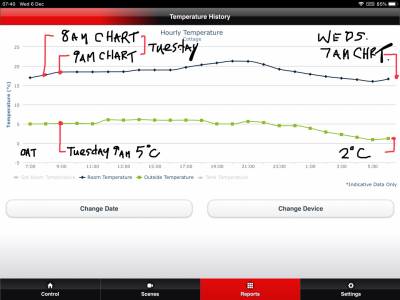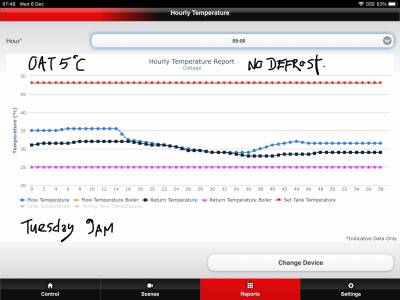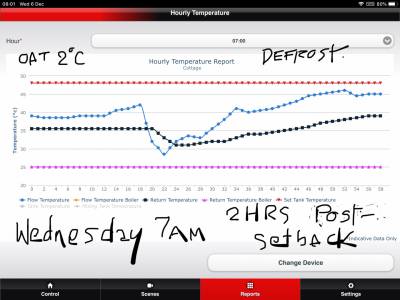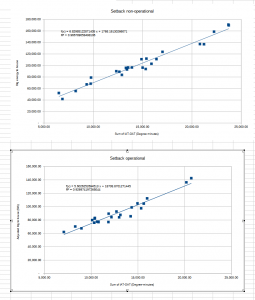I think @jamespa quoted you are thinking there is only a 5% saving when operating a setback. This obviously seems a small saving for the effort of doing a setback.
I personally don’t think I’m experiencing this in practice. And in an extreme case I recently did a huge setback for 7 days dropping down to 12c IAT. SO SAVING 7days at circa 12kwh per day X 6 and circa 24 kw on the last day when OAT dropped to -3. It took a 24 hour continuous operation at 20c to recover but that only required 40 kWh for that day.
Regarding defrost
this is where there appears to be significant energy increases and recovery time.
the last 24 hours bears this out where yesterday morning at 5c OAT resulted in 16.5kwh whereas this morning it is 2c. So I’ve compiled a few charts showing the significant DT signitures. I’ve placed the charts on a 24 hour graph to relate OAT to the time of 5e heating charts
The difference in energy signature between a soft restart of the HP compared to a post defrost restart is obviously absent in my MELCloud charts but we know they are a significantly burden.
yesturdays estimated energy usage was 16.65 with a COP4.06. I will have to wait for 12pm tonight to see what today’s energy usage will be.
Posted by: @sunandairI think @jamespa quoted you are thinking there is only a 5% saving when operating a setback. This obviously seems a small saving for the effort of doing a setback.
I personally don’t think I’m experiencing this in practice. And in an extreme case I recently did a huge setback for 7 days dropping down to 12c IAT. SO SAVING 7days at circa 12kwh per day X 6 and circa 24 kw on the last day when OAT dropped to -3. It took a 24 hour continuous operation at 20c to recover but that only required 40 kWh for that day.
The quote related to the circumstance when setback and recovery both occur within 24hrs. A longer setback such as 7 days for holiday is a totally different situation and is a no brainer, it will save money.
With regard to shorter setbacks it has become clear, both from modelling and analysis of data provided by @cathoderay, that the energy stored in the fabric really matters and thus any comparisons must either take this into account or be between points in time where the IAT is identical. Even small deviations in IAT can hide a large energy deficit, which eventually must be made up. Unless these are properly accounted for then its all too easy to over estimate the energy saving due to setback.
4kW peak of solar PV since 2011; EV and a 1930s house which has been partially renovated to improve its efficiency. 7kW Vaillant heat pump.
If you find an IAT of 12C acceptable, then why not run your system at this temperature permanently, and save even more money.
. @derek-m very funny
realizing that’s you just being your humourous self I won’t bother reminding you and James that I did say it was an extreme example. However it is a relative problem of “how much” set back and Perhaps more significantly how does your model pigeon hole the emotive unmeasurable interpretation of ’Comfort’.
The very real and significant energy cost of defrosting is however, measurable if you could cancel out the actual colder temperature and just identify the cost of the defrost cycle that might be useful.
Regarding the model I am convinced that Cathoderay’s mass and energy absorption gives you a distorted figure so any value is likely to not be typical. I’m not sure if you differentiated between mass energy stored in an external wall compared to a mass store in an internal (eg) stone or concrete wall. I am sure that the heat loss from an external wall will be faster than from the equivalent wall if it were internal. Therefore the actual benefit of the mass store is compromised by the loss of heat outside the envelope. But perhaps you’ve accounted for this?
its easy to put down anecdotal information like the comments I made above with sweeping generalisations like those that James has done above. But to put them across as tho they are fact is really absurd... thanks James.
So in the mean time I will continue with a 16C setback from 9.15pm to 6am with a slow 3 hour reheat back to 19C and 21C for the evening using our low mass for the fast recovery. Blissfully Aware that ive saved real energy in the process.
Look again at the charts in the middle of the morning reheat. The HP is not boosting the heat into the system it is quietly putting a DT of around 3c which is scarcely trying. Whereas the defrost recovery is forcing the DT to 7 or 8C.
Posted by: @sunandairI think @jamespa quoted you are thinking there is only a 5% saving when operating a setback. This obviously seems a small saving for the effort of doing a setback.
The latest analysis by @jamespa of my Midea data (see recent posts in this thread) suggests the savings may be higher, around 20%, for a six hour overnight set back, but the results don't quite reach statistical significance (but may do when we have more data). There are also some other things that need explanation, see posts above on the intercepts.
The question of longer setbacks being a no brainer has bothered me for some time. Given that they are a no brainer, how short do they have to be to become 'a brainer' ie something that isn't straight forward? How and when does that transition occur? I think the answer is when the setback occurs within a 24 hour time frame, and 'full accounting' for all energy in and out is taken into account, but would welcome @jamespa's comments on this.
Midea 14kW (for now...) ASHP heating both building and DHW
Posted by: @sunandair. @derek-m very funny
realizing that’s you just being your humourous self I won’t bother reminding you and James that I did say it was an extreme example. However it is a relative problem of “how much” set back and Perhaps more significantly how does your model pigeon hole the emotive unmeasurable interpretation of ’Comfort’.
The very real and significant energy cost of defrosting is however, measurable if you could cancel out the actual colder temperature and just identify the cost of the defrost cycle that might be useful.
Regarding the model I am convinced that Cathoderay’s mass and energy absorption gives you a distorted figure so any value is likely to not be typical. I’m not sure if you differentiated between mass energy stored in an external wall compared to a mass store in an internal (eg) stone or concrete wall. I am sure that the heat loss from an external wall will be faster than from the equivalent wall if it were internal.
its easy to put down anecdotal information like the comments I made above with sweeping generalisations like those that James has done above. But to put them across as tho they are fact is really absurd... thanks James.
So in the mean time I will continue with a 16C setback from 9.15pm to 6am with a slow 3 hour reheat back to 19C and 21C for the evening using our low mass for the fast recovery. Blissfully Aware that ive saved real energy in the process.
Look again at the charts in the middle of the morning reheat. The HP is not boosting the heat into the system it is quietly putting a DT of around 3c which is scarcely trying. Whereas the defrost recovery is forcing the DT to 7 or 8C.
Whatever works for you.
Posted by: @cathoderayThe latest analysis by @jamespa of my Midea data (see recent posts in this thread) suggests the savings may be higher, around 20%, for a six hour overnight set back, but the results don't quite reach statistical significance (but may do when we have more data). There are also some other things that need explanation, see posts above on the intercept
That's not the case once you take into account the intercept. Below are the graphs. There is a saving above about 14,000 degree minutes per day (average OAT about 10C) and it currently reaches about 3% at 20K degree minutes (average OAT about 7 C). We don't currently have data beyond 20,000 degree minutes, but doing a linear extrapolation would get us to ~5% at 24,000 degree minutes per day, which is the maximum this year so far (ie the cold snap in December). Below 14,000 degree minutes per day the best fit says that setback costs money. The uncertainty is still too great to consider this a conclusion but no way does the experimental data currently suggest that there is a saving of 20%.
i will try to find a way to superimpose them so that they are easier to compare.
4kW peak of solar PV since 2011; EV and a 1930s house which has been partially renovated to improve its efficiency. 7kW Vaillant heat pump.
@cathoderay thanks for that update youre right imo, and that’s why I started with the extreme example ... 20% is significant although JPA might still want to caveat it out of existence.
Posted by: @sunandair@cathoderay thanks for that update... 20% is significant
You may wish to read my post here https://renewableheatinghub.co.uk/forums/postid/24420 (just a couple up). I don't agree with 20%!
4kW peak of solar PV since 2011; EV and a 1930s house which has been partially renovated to improve its efficiency. 7kW Vaillant heat pump.
@sunandair - I am very aware that at times @jamepa and @derek-m can come across as patronising self-appointed experts who know it all, and the rest of us are but mere ants to be trodden upon by their giant feet. I'm also inclined to the view that @derek-m's alleged (by none other than himself) sense of humour may in fact be clinically rather interesting, and might even yield valuable insights if subject to suitable analysis. But such analysis can only be done in person, and so won't happen.
I also think, and have said before many times, both here and elsewhere, that all analysis must be fully visible, and comprehensible to those with sufficient interest and intellect (which I pitch at around the equivalent of attained, or would have attained, A levels). The moment you have black box modelling you are on a very slippery slope, because others can't verify the claims made by the modellers. I would even go so far as to say it is pseudo-science, because independent verification is absolutely and totally at the core of science, without verification there is no science.
When I was a young junior doctor, most doctors if they put their mind to it could understand most research papers. That meant they could question the results. Over the last couple of decades the methods have become increasingly complex, and I now often find myself totally baffled by the methods and analysis sections of published research. I am not stupid, and if it is all mumbo jumbo to me, then it will also be mumbo jumbo to most doctors. In short, it becomes black box science.
Couple black box science with arrogant and patronising scientists and you have the makings of a very toxic brew. The last time that happened on a global scale was during the covid pandemic, and look what a mess that got us into. The damaging effects of the response to the pandemic, guided by 'the science' (of course there is no such thing as 'the science') are still very much with us today, long after what was in reality mo more than just another (albeit new to a previously unexposed population, so high initial attack rates were to be expected) flu like illness has blended into the background winter respiratory tract infections.
Midea 14kW (for now...) ASHP heating both building and DHW
Don't panic, I've taken my Meds today.
- 26 Forums
- 2,111 Topics
- 46.4 K Posts
- 42 Online
- 3,402 Members
Join Us!
Latest Posts
-
RE: No-code, plug-and-play monitoring for your heat pump
@benson It is a shame, I was looking at these when I wa...
By Grantmethestrength , 13 hours ago
-

RE: BUS Grant: removal of all other fossil fuel heat sources
@rikiarn - just have a think as to how much it will cos...
By Transparent , 13 hours ago
-

Don't do much digging around.That's best left to the pr...
By Transparent , 13 hours ago
-
Hi all, I was wondering if anyone had an idea of how th...
By Wh0am3ye , 16 hours ago
-
RE: EBAC re-entering the ASHP market in 2023
@toodles confirm i have Ebac 5kw ASAP + homely and it w...
By marcinwloch69@gmail.com , 18 hours ago
-
RE: Compute heat loss from energy used
@jamespa Ebac must be similar to Mitsubishi as they buy...
By marcinwloch69@gmail.com , 18 hours ago
-
RE: Is a Valliant Inline 6kW heater a BUS buster?
When i was looking I encountered one installer who does...
By JamesPa , 19 hours ago
-

@pie_eater I have been thinking of adding cooling to my...
By TechnoGeek , 3 days ago
-
RE: Victorian Semi Retrofit / Extension ASHP and UFH Advice
Agree, but you may have a hard time convincing them, as...
By JamesPa , 4 days ago
-
RE: Seal the Deal: Don't Let Your Heat Pump Leak Energy
Hi - fyi - there's a dead image link in the 'Optimal In...
By seatonian , 5 days ago
-

RE: Ripped Off: How UK Homeowners Are Paying Gas Prices for Wind Energy
@chandykris Horses and beggars…. 😉 Toodles.
By Toodles , 5 days ago
-

RE: Cleaning up after gas meter removed
@agentgeorge Likewise in the loft space; we have 300mm ...
By Toodles , 5 days ago
-
RE: Ecodan consuming 100kwh per day in new build!!!
This particular example is one of the worst I have seen...
By JamesPa , 5 days ago
-

-
RE: Fan running in hot weather ...why?
I wonder if it has some kind of pressure transducer to ...
By ASHP-BOBBA , 6 days ago
-
RE: Cooling with Samsung Gen6 and Flow error
@iaack The system isnt running long enough for any cond...
By EcoBaker , 6 days ago
-
@heacol thanks for confirming we can only hope NAPIT ag...
By Bart , 6 days ago
-

Sorry to hear that @bruce. Sadly I’ve heard from multip...
By Mars , 1 week ago









